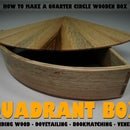Introduction: Continuous Grain Dovetail Box - a Great Gift Idea
Ever wondered how to make a box where the grain (or figure to be more precise) wraps right around. Well it's fairly simple, as I'll show you with this dovetailed box made from Milk Pear.
To see the process in action, you can watch the video.
Little boxes make great gifts, and home made ones are so much more special - I know who mine is going to, how about yours?
If you enjoy my instructable, please vote for it in the Home Made Gifts contest
Step 1: Initial Preparation for Sides
First prepare your wood:
To ensure the continuous grain around the box, we will be re-sawing the wood for the sides, so initially this should be prepared a little over twice the thickness that you want the sides to be
- Smooth one side (the face side)
- Square one edge to the face side (shoot the edge as I'm doing in the photo)
- Saw a length that equals the sum of the box's length and width plus an allowance to saw these apart and square the ends
- Square the ends (a shooting board is a real help )
- Gauge a line to define the height of the box
- Saw the board's width to the height you just gauged plus a tad for cleaning up
- Plane the sawn edge smooth
- Smooth the reverse of the face side, ensuring the thickness is the same all overS
Step 2: Re-Sawing Sides
To re-saw the sides:
- Gauge the mid-point of the board's thickness
- Saw all the way around to about half an inch deep (the backed saw helps keep cuts straight)
- Deepen the saw cuts, keeping the blade within the cuts on two sides
- Complete with a backless saw if needed
- Smooth the re-sawn faces
Step 3: Tails and Pins
Joint cutting:
- Gauge the thickness of the pin board on the end of the tail board, and vice-versa (remember to keep the pieces such that the grain flows correctly. The re-sawn faces are to the outside of the box)
- A clamped on 'backer' board is helpful
- Mark in for the tails with a dovetail gauge or bevel gauge set to about 7:1 for hardwood, 5:1 for softwood)
- Saw the sloped sides of the tails
- Chop out the waste from the tail board
- Align the corner, and transfer the tails to the pin board
- Saw the plumb sides of the pins
- Chop out the waste from the pin board
Repeat for the opposite corner joint
After the two opposite corners are completed, saw the two boards to release the sides and ends of the box, and shoot the four new ends so that they are square, and that the lengths of the sides and ends match their respective pieces
Repeat the joint cutting for the two remaining corners
Step 4: Assemble the Sides
When all the corners fit well, apply glue and assemble
Rest on a flat surface and apply light clamp pressure to press the tail borads onto the pin boards
Check the sides are square to each other, and apply pressure across opposite corners if necessary to achieve this
Once the glue dries:
Flush the joints up with a plane
Set on a piece of ply or mdf (4mm in this case), and mark for an inset base
Saw and plane the base to a snug fit
Glue the base in, leaving the sides a tad proud at the bottom, which will allow it to sit better
Step 5: Prepare the Lid
Cut a lid to suit. I chose to have mine overlap a little all around, and attached contrasting sapwood to the heartwood as a feature
Thickness the lid
Gauge in for a rebate, so that the bottom of the lid will fit into the box
Plane the rebate with a shoulder plane (or saw and clean up with a chisel or scraper)
Step 6: Cushioned Top (optional)
You can create a cushioned top by first rounding over each half across the grain, then with the grain
Step 7: Finish
Apply your chosen finish
That's all there is to it!
Thanks for looking in, see you again soon
Mitch
For more like this, subscribe here on Instructables, and also on YouTube
Little boxes make great gifts, and home made ones are so much more special - I know who mine is going to, how about yours?
If you enjoy my instructable, please vote for it in the Home Made Gifts contest




